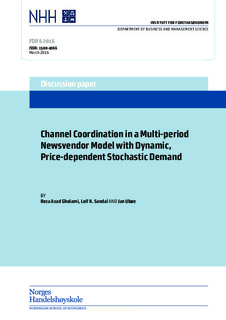Channel Coordination in a Multi-period Newsvendor Model with Dynamic, Price-dependent Stochastic Demand
Working paper

Åpne
Permanent lenke
http://hdl.handle.net/11250/2382454Utgivelsesdato
2016-03-17Metadata
Vis full innførselSamlinger
- Discussion papers (FOR) [566]
Sammendrag
In this study, we extend the single-period newsvendor problem with stochastic demand into a multi-period and time-dependent one and find a solution for it. We analyze the multi-period newsvendor problem with stochastic demand in a Stackelberg framework where the wholesaler is the leader and the retailer (newsvendor) is the follower. We use an additive-multiplicative structure for the demand so that both its mean and variance are considered as functions of the current retail price. Moreover, in our model, the demand mean and variance can be either time-dependent or autonomous with respect to time. A price-dependent memory function is also embedded in this representation of demand that carries the effect of demand level at present over to the demand in future. This leads to a strategic game in which the players must balance immediate high profits
with reduced future earnings. We propose a complete solution to this stochastic multi-period Stackelberg game, covering cases with finite and infinite horizons. The theory is illustrated by using Cobb-Douglas demand functions as the deterministic part, while a random variable brings in stochasticity into the model. Because our theory is very
flexible with respect to the assumptions made about the demand, market memory, and the behavior of the two agents, it is applicable to a wide variety of functional forms and capable to model many different economic contexts.